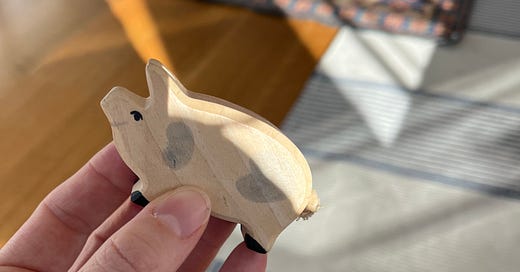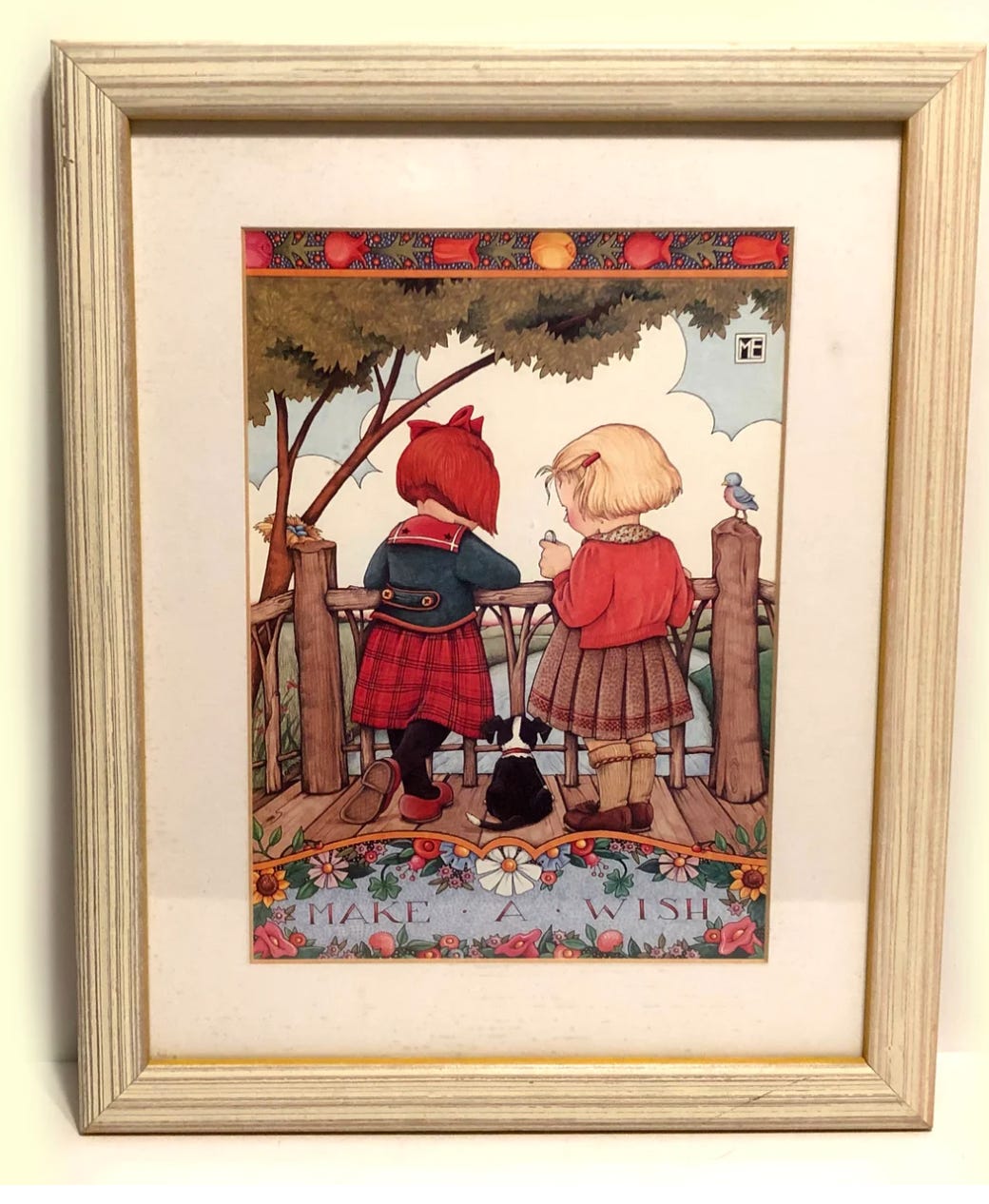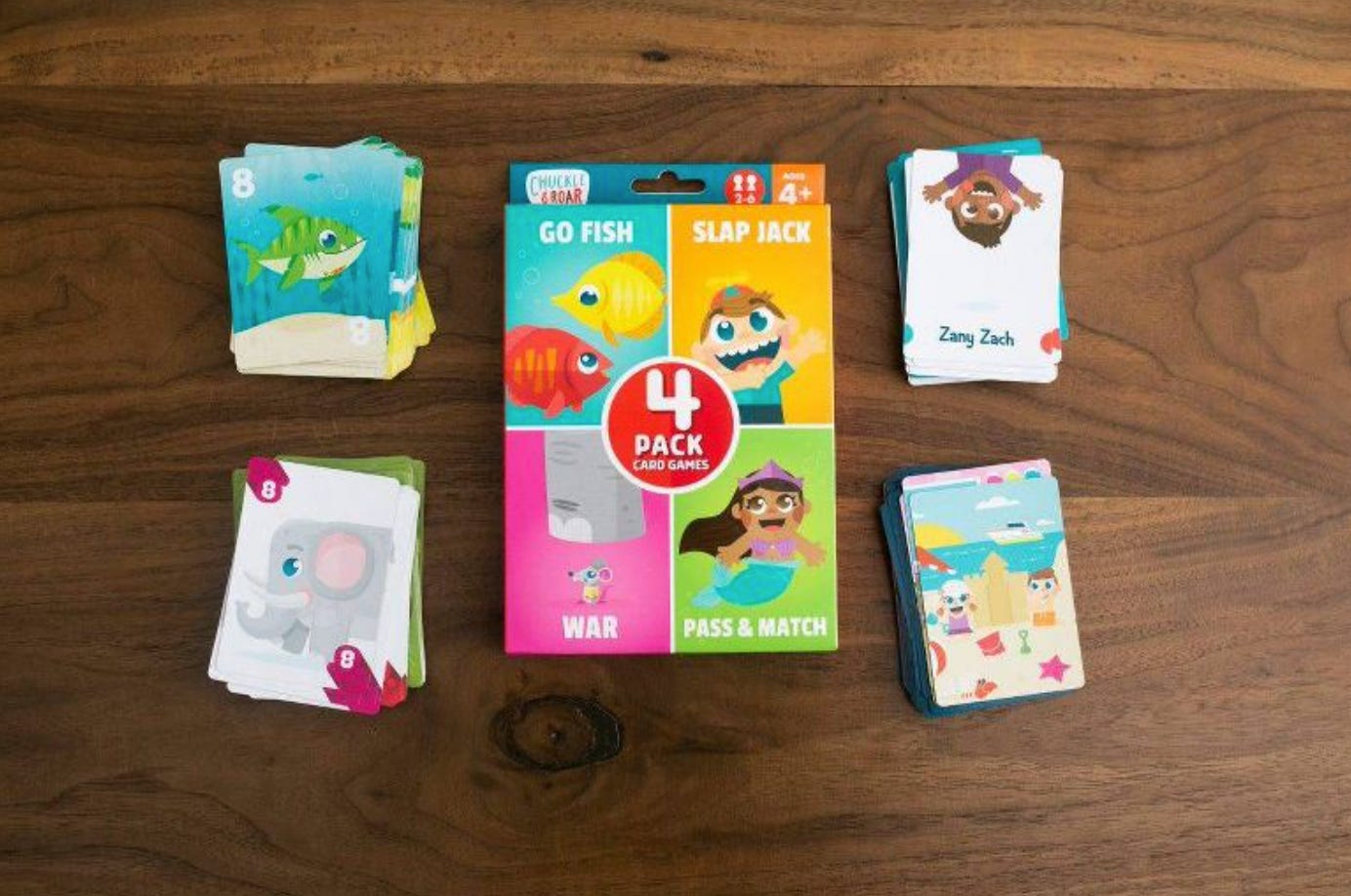Performing my motherhood through wooden toys
On why some toy gift guides are really just for the grownups
I talked a lot of trash about aspirational gift guides here, but the truth is, I love aspirational gift guides. Viewing an aesthetically pleasing collage of objects is catnip to my pretty-loving soul, I feel soothed anytime something or someone that isn’t me tells me what to do (or buy), and I crave the dopamine bursts triggered by internet treasure hunts.
Mostly though, choosing to believe that the buying and owning of aesthetically pleasing things will contribute to making my life more attractive, more fulfilling, more _____, even though I know that aesthetically pleasing things are only capable of offering fleeting sparks of pleasure rather than meaningful wellness is a type of magical thinking I’ve been practicing every since I started lusting after Mary Engelbreit posters for my extremely twee bedroom at the tender age of twelve.
But I also hate gift guides because gift guides are like an IV of aspirational consumerism shot straight into the vein rather than the humdrum slow drip of everyday life in a capitalist society. And there’s something about gift guides for kids in particular that clearly elucidate the root silliness of believing in the power of consumerism to = true wellbeing. Because more often than not, gift guides for kids are really just metrics by which mamas might judge their own [“good”] taste. And “good” taste in the mamasphere is just another way of communicating one’s “good” motherhood. Even if the only person you’re communicating with is yourself.
Let’s take a look at this gift guide.
I know absolutely nothing about the blog from which I sourced this gift guide, so have nothing to say about the momfluencer behind it. I chose this gift guide because it’s exactly the type of thing I’m drawn to in the realm of cute kid shit. All of these items are attractive (to me!) and it’s fun to imagine that owning them would not only contribute to prettifying my bathroom counter, but might also elicit inner beauty in my kids. Maybe my kids will play a round of Go Fish without vociferous accusations of cheating if the pack of cards they’re playing with is cuter than the average pack of cards. (See above statement about magical thinking)
And now for an analysis of individual objects and what the potential purchase of said objects is saying (or not saying) about me and my motivations.
I love Oliver Jeffers so would love to buy this cuter-than-typical pack of playing cards even if the alternative is half the price and includes four games rather than three. By purchasing this card pack, in addition to buying something cute, I’m communicating my in-status as someone who appreciates and reads whimsical, literary kids’ books.
I love good branding so would love to buy a pink and red bottle of toothpaste emblazoned with cool typography simply because it sparks more joy (for me) than my kids’ go-to tube of Paw Patrol themed Orajel. By purchasing this toothpaste, in addition to buying something cute, I’m communicating my aesthetic preference for clean lines and unexpected color combinations, by which I imagine I’m communicating my inner artist.
I love wooden toys so would love to buy a wooden toy camera because I enjoy looking at it more than I enjoy looking at My First Camera even though the wooden toy camera does nothing (other than look cute) and My First Camera has “lights and sounds for endless hours of fun,” flashing lights, buttons that make clicking noises, and most crucially, “clever music.” By purchasing this wooden camera, in addition to buying something cute, I’m communicating my desire to foster my child’s imaginative independence as well as my awareness that plastic (among other things) is destroying the planet.
I love whimsical animals so would love to buy a set of whimsical wooden toy animals rather than the plastic version of the Heeler family. By purchasing this set of whimsical wooden toy animals instead of Bluey et al, I’m communicating that my kids don’t need the familiarity of a TV dog family to have fun.
I love this adorable knit crown even though it costs $41.00 and the below crown and wand combo pack is $20.00 and is fancier (read: sparklier) than the adorable knit crown so would be a far safer bet for a fancy-loving kid. By purchasing this adorable knit crown, I’m really just telling the world that I value my aesthetic preferences over my Fancy Nancy-or-bust kid’s potential enjoyment.
In almost every case, my kids (the people for whom I’m shopping) would prefer the brighter, louder, cheaper toy to the beiger, quieter, more expensive toy. I buy the cute kid shit for me. Not for them.
Because I’m a millennial mom and have been trained by capitalism (and the promise of millennial aesthetics to communicate something vital about my personhood) to view my motherhood as something I can shop for, I keep longing for (and sometimes buying) the pretty tubes of toothpaste even though the pretty tubes of toothpaste will not make the job of coaxing a reticent toddler to practice adequate oral hygiene any easier. The pretty tubes of toothpaste will not make any more or any less of my motherhood. They will, however, indicate something about my socioeconomic class and my adherence to certain agreed-upon cultural mores having to do with childhood and mothering.
I read and loved Kyle Chayka’s examination of millennials’ love affair with minimalist aesthetics in his book Longing for Less, and this quote seems important to understanding my love/hate relationship with cute kid shit gift guides full of blond wicker strollers and ecru colored sippy cups:
“The veneer of minimalist style becomes like an organic food label, expensive green juices, or complex skin treatments being sold as a ‘no-makeup’ look. It’s another class-dependent way of feeling better about yourself by buying a product, as Spartan as the product might be. It takes a lot of money to look this simple.”
It does take a lot of money to “look this simple,” and kid shit is no exception. And while Chayka’s point about minimalism is a broad one encompassing interior design, personal care, food, and more, I want to pause and consider how it shows up in cute kid shit specifically. The desire to showcase one’s class status or one’s “good” taste through cute kid shit does more than simply communicate one’s supposedly superior aesthetics. These purchases often are also meant to (consciously or not!) communicate something about one’s goodness as a parent. I am a good parent because I am protecting my children from parabens. I am a good parent because I am encouraging my kid to strengthen his imagination instead of rely on “clever music” and clicking camera sounds. I am a good parent because my kid doesn’t watch enough TV to lust after a Bluey figurine. I am a good parent because my kid’s costume crown is . . . less sparkly than your kid’s costume crown?
While of course, purchasing certain items for one’s child can indicate a parent’s earnest desire to foster creativity, independence, or growth for one’s kid, the line between wanting what’s best for our kids and wanting what one perceives to look best is a blurry one.
And, as with most things in today’s culture of parenting, the onus is on the individual to do everything right [make everything look right] rather than on big systems and power structures. Ideally, for example, one of those systems would be tasked with protecting all kids (regardless of their parents’ aesthetic preferences or income bracket) from potentially damaging additives and chemicals, and ideally one of those systems would ensure that all kids have access to quality, affordable preschools, at which all children’s imaginative potential would be challenged and nourished.
My kid gift guide critique is not leveled towards me or anyone else who is entranced by cute kid shit. Life is too short to shame yourself for buying the cute wooden piglet for YOURSELF and calling it a stocking-stuffer for your kids. To crave and pursue beauty is a deeply human desire, and as highly aesthetically motivated person, one of my favorite hobbies. My critique is aimed instead at a culture which too often confuses aesthetics with worthiness, too often prioritizes performative motherhood over individuals’ lived experiences of mothering, and too often encourages us to purchase our maternal wellbeing instead of experience it.












I loved the way you really deconstructed what each item is saying about you as a mom-- and articulated that these aesthetically pleasing gifts are for you, not for your children. When my kids were little and at a play based, nature-centered preschool, I remember my older daughter bringing a Daniel Tiger stuffy to school one day and the other parents (pretending?) not knowing what it was. I was so lonely in those days, and I so remember feeling that if I could only buy the right stuff, I’d belong.
Wow, right at me. I was given the wood camera from a friend (he didn't play with it), we have the Paw Patrol toothpaste, and I got the Go Fish cards for my son for Christmas. Love this.